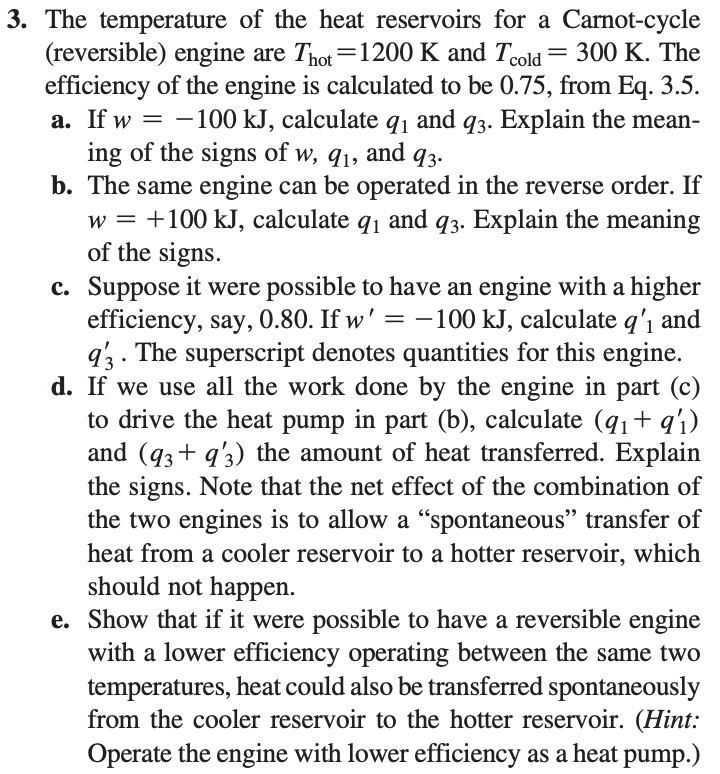
The temperature of the heat reservoirs for a Carnot-cycle (reversible) engine are Thot=1200K and Tcold=300K. The efficiency of the engine is calculated to be 0.75, from Eq. 3.5. a. If w=100kJ, calculate q1 and q3. Explain the meaning of the signs of w,q1, and q3. b. The same engine can be operated in the reverse order. If w=+100kJ, calculate q1 and q3. Explain the meaning of the signs. c. Suppose it were possible to have an engine with a higher efficiency, say, 0.80. If w=100kJ, calculate q1 and q3. The superscript denotes quantities for this engine. d. If we use all the work done by the engine in part (c) to drive the heat pump in part (b), calculate (q1+q1) and (q3+q3) the amount of heat transferred. Explain the signs. Note that the net effect of the combination of the two engines is to allow a "spontaneous" transfer of heat from a cooler reservoir to a hotter reservoir, which should not happen. e. Show that if it were possible to have a reversible engine with a lower efficiency operating between the same two temperatures, heat could also be transferred spontaneously from the cooler reservoir to the hotter reservoir. (Hint: Operate the engine with lower efficiency as a heat pump.) The temperature of the heat reservoirs for a Carnot-cycle (reversible) engine are Thot=1200K and Tcold=300K. The efficiency of the engine is calculated to be 0.75, from Eq. 3.5. a. If w=100kJ, calculate q1 and q3. Explain the meaning of the signs of w,q1, and q3. b. The same engine can be operated in the reverse order. If w=+100kJ, calculate q1 and q3. Explain the meaning of the signs. c. Suppose it were possible to have an engine with a higher efficiency, say, 0.80. If w=100kJ, calculate q1 and q3. The superscript denotes quantities for this engine. d. If we use all the work done by the engine in part (c) to drive the heat pump in part (b), calculate (q1+q1) and (q3+q3) the amount of heat transferred. Explain the signs. Note that the net effect of the combination of the two engines is to allow a "spontaneous" transfer of heat from a cooler reservoir to a hotter reservoir, which should not happen. e. Show that if it were possible to have a reversible engine with a lower efficiency operating between the same two temperatures, heat could also be transferred spontaneously from the cooler reservoir to the hotter reservoir. (Hint: Operate the engine with lower efficiency as a heat pump.)







